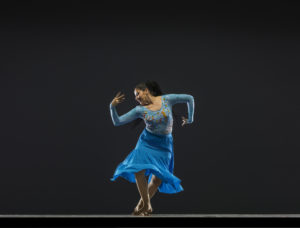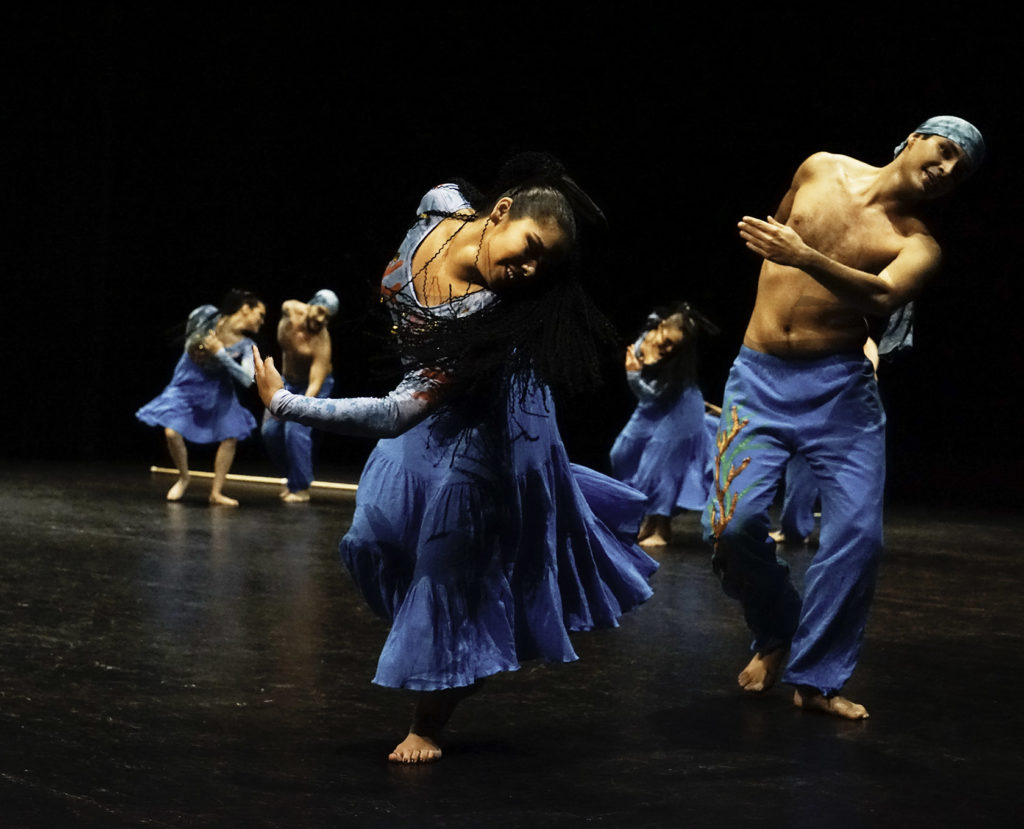

One of the wonders of the San Francisco Bay Area is the breadth of cultural dance forms being sustained here and available for audiences to experience. The San Francisco Ethnic Dance Festival is one of the best places to witness that breadth, and highlighted that role in 2016 when they presented Nicaragua Danza, Hijos del Maíz, a local company led by Artistic Directors Luis Leon and Grace Torres.
Nestled between performances from two Festival mainstays (LIKHA – Pilipino Folk Ensemble and Dunsmuir Scottish Dancers (such is the mercurial world of an Ethnic Dance Festival), Nicaragua Danza, Hijos del Maíz introduced Nicaraguan dance to the wider dance community at the Festival in a trio of pieces collectively titled Somos Nicaragua Multiétnica (We are Multiethnic Nicaragua). It was a vibrant introduction to dances from Nicaragua’s Atlantic coastal region, the Miskito Coast. The pieces included traditional indigenous Miskito dances, dances drawn from Afro-Caribbean cultural traditions, and a Creole mixture of African and European dance forms that formed during the era during the 18th and 19th centuries when Britain was a dominant presence in the region.
When I spoke with Grace, she began by explaining that the company’s name, Hijos del Maíz, which translates to “Children of the Corn,” was chosen because corn is a central commodity incorporated into almost every meal, and has strong cultural currency in Nicaragua. “As a cultural-folkloric group, we wanted our name to have a connection to that culture,” Grace further explained that “there’s also a song, [“Somos Hijos del Maíz”] from a member of the Mejia family, which is this famous musical family in Nicaragua, [that] lists all the ways corn is important to the country.” The company seeks to honor all of corn’s many cultural references.
Grace was raised in the capital city of Managua, on Nicaragua’s Pacific side, and she didn’t visit the Atlantic side until relatively recently. Nicaraguans are introduced to dance as a national cultural form very early. She tells me that, “unlike here [in the U.S.], where dance is an elective… in Nicaragua, dance is part of your regular curriculum from a young age and the dance that is taught is folkloric…everyone learns these songs and the basic steps as little kids,” in school.
While she was in school, Grace trained with Blanca Guardado who was also founder and director of one the national Nicaraguan folklorico ballets, Ballet Folklórico Tepenahuatl. “One day when I was about 17 I asked her if I would be good enough to be in that Ballet, and when that would be,” Grace explains, “she laughed and said, ‘well, you can do it now.’” That was the beginning, and for Grace there was nothing better than the experience of being part of a large dance company, performing on a regular basis.
When I asked her to share something from her mentor that she now seeks to instill in the dancers she works with, she explains that it’s all about the repetition. “I’m focused on making the dancer better. I focus on the practice. In dancing, it’s all about the repetition – your muscles need to know the choreography so if your mind goes blank in the middle of a performance, your body will still push through.”

Despite her love of dance, there was a long break from dancing after Grace moved to the U.S. in 2004. After a few years she began feeling the urge for what she calls the “structure of group dance with rehearsals.” She continues, “the rehearsal part, the process, that work is what really excites me. That process of seeing how a few steps and some patterns can create something so big and beautiful to watch.”
She was stymied in her attempts to find a Nicaraguan dance company. “There was one group that did it a little bit,” Grace acknowledges, “but although the person who ran it did it out of a love for Nicaragua, she honestly didn’t know much. It felt like she was looking at videos on YouTube and trying to mimic them. But I didn’t want to be the dancer telling the director, ‘you’re doing it wrong,’ so I just didn’t go back.” Instead, Grace danced with other companies that practiced Afro-Haitian and Afro-Peruvian traditions. Then one day, Luis Leon got in touch with her.
Luis, now Hijos del Maíz’s primary director, had danced in one of the other large Nicaraguan dance companies, Ballet Folklórico Nicaraguense, led by Francisco González. He had moved to the Bay Area and had heard that Grace had danced with Ballet Folklórico Tepenahuatl. “He came to my house, and we started talking – he and his wife both dance,” she explains, and very suddenly they decided to form the company in 2011. “We started very small and now we have a nice group of people.”
The company originally had four directors, but as one might expect that wasn’t a sustainable model. “It was too many people saying, ‘no I want to do this,” so we decided we need one director, and whatever that person says goes,” she tells me. So “we decided that Luis is the director and I am the right hand.” Grace further explains that “Luis and I share responsibility with the adult company, and I am very big on cleaning up the movement and making sure that we are connecting and turning at the same time. But Luis takes care of the kids and does all of the choreography for them, the costumes, everything.” The company’s rehearsals are very structured and focused on upcoming performances, so she says that “it’s very rare that we just work specifically on movement, there’s always a show that we are preparing for, especially the kids, the kids dance a lot, even more than us.”
Their Rotunda Dances Series performance at San Francisco’s City Hall on December 1st will feature both companies. They are bringing their youth group to do five short folkloric pieces. Then the adult company will perform a piece from the Atlantic coast, that was set on the company by choreographer Cleopatra Morales, who was a college instructor of Luis’ in Nicaragua and is well known for opening the dances of the Atlantic coast to a wider audience.
I ask Grace about their hopes for the future of their company, and she shares that “we really want to help our students – kids and adults – grow as dancers…we would also love to be able to take our dancers to Nicaragua.” As a start they recently invited Cleopatra Morales to work with the company, and Grace says “it was hard financially but we made it work and it was doable. We want to do more of that.” The company – like so many others practicing cultural dance forms in the Bay Area – is also on the lookout for space. “we are looking to create more stability to have space to create and practice our cultural forms with young people,” Grace continues, “so that Nicaraguan groups—not just us, but other companies coming up have a space to create.”
When I ask Grace about her personal hopes she reveals that “since I was a little girl, I wanted to be a dancer. I decided a few years ago that I’m not going to be able to live off of dancing. My husband is a Salsa teacher and has the blessing of making living out of it. But Luis and I have our 9 to 5 jobs, and we do this out of love.” And to that end, she says that “I feel fulfilled as long as I can keep doing what I’m doing. As long as I can dance, and keep learning, and work with other dance companies, and can see my group growing, that fulfills me and that’s enough.”
At one point in our conversation, Grace tells me that when she was member of Ballet Folklórico Tepenahuatl in Nicaragua, her focus was on “the steps and the movements, but I didn’t know much of the history of that piece. I didn’t ask enough questions.” But, she tells me that “from Luis I’ve really learned to not just be a dancer, but to ask questions to try understand why we dance, and why the dance exists. It’s more than just the steps.” She conclude by saying, “I think if I put a little more effort on that side, and making sure all our dancers have that knowledge too, the dancing will keep getting stronger.”
This article appears in the December 2017 issue of In Dance.


